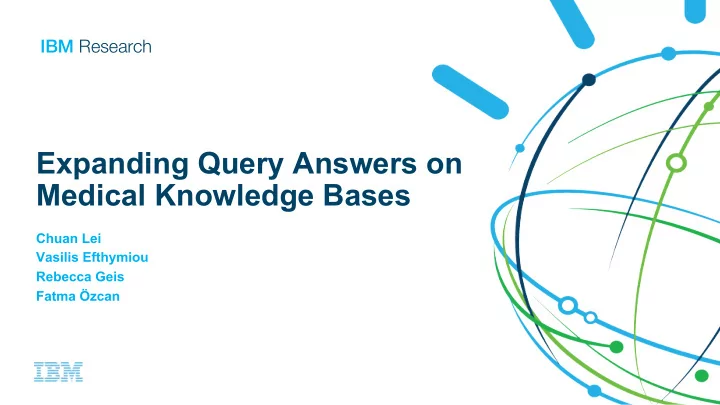

IBM Research Expanding Query Answers on Medical Knowledge Bases Chuan Lei Vasilis Efthymiou Rebecca Geis Fatma Özcan
IBM Research Querying medical knowledge bases 2
IBM Research Query relaxation Not in the medical KB Problem: Users do not always formulate their queries precisely to match the terms in the KB Ø No answer or incomplete answers returned Goal: Query relaxation (QR) transforms the query in a way that the user's intent is better represented Ø greatly improving the flexibility and usability of a medical KB Contributions : • an effective offline external knowledge source incorporation • a novel similarity metric to identify semantically related concepts • a programmatic way to incorporate our QR into existing systems • experimental evaluation shows our QR outperforms existing methods 3
IBM Research Two-phase approach (overview) Medical Knowledge Base External Knowledge Source External Concepts T-Box Domain Ontology Mapping A-Box … … … Instances Offline phase ( aka external knowledge source incorporation): (i) Initialize the set of contexts, (ii) compute concept frequencies, (iii) generate mappings Online phase ( aka online query relaxation): (i ) map query term to external concept, (ii) return top-k external concepts 4
IBM Research External knowledge source incorporation Mapping medical KB to external knowledge source Ø exact match / fuzzy match / embeddings / … Head finding [Pain of head and neck region] <Indication-hasFinding-Finding, 18878> <Indication-hasFinding-Finding, 19164> <Risk-hasFinding-Finding, 1656> <Risk-hasFinding-Finding, 1656> The context of a query term can be represented by a relationship and its associated concepts from the domain ontology Craniofacial pain [Pain in throat] <Indication-hasFinding-Finding, 18878> < Indication-hasFinding-Finding, 283> <Risk-hasFinding-Finding, 1656> <Risk-hasFinding-Finding, 0> Concept frequency 𝑔𝑠𝑓𝑟 𝐵 = 𝐵 + ( 𝑔𝑠𝑓𝑟(𝐵 # ) [Headache] context-aware <Indication-hasFinding-Finding, 18878> frequencies ! ! ⊑! <Risk-hasFinding-Finding, 1656> Information content-based similarity Dental headache Frequent headache 𝐽𝐷 𝐵 = −log(𝑔𝑠𝑓𝑟 𝐵 ) <Indication-hasFinding-Finding, 0> <Indication-hasFinding-Finding, 0> <Risk-hasFinding-Finding, 0> <Risk-hasFinding-Finding, 0> 𝑡𝑗𝑛 $% 𝐵, 𝐶 = 2×𝐽𝐷(𝑚𝑑𝑡 𝐵, 𝐶 ) 𝐽𝐷 𝐵 + 𝐽𝐷(𝐶) 5
IBM Research Online query relaxation Generalization vs specialization Disorder of lower Disorder of lower generalize specialize respiratory system respiratory system specialize (1) generalize (0.9 4 ) (0.9 2 ) (1) Lower respiratory Disorder of lung Lower respiratory Disorder of lung tract infection tract infection generalize specialize (0.9 3 ) (1) Pneumonitis Pneumonitis 𝑞 !,' = 0.39 𝑞 !,' = 0.66 generalize specialize (0.9 4 ) (1) Pneumonia Pneumonia |)| )*# 𝑞 !,' = ; 𝑥 # The weight of a path connecting two external concepts A and B: # Overall concept similarity: 𝑡𝑗𝑛 𝐵, 𝐶 = 𝑞 !,' ×𝑡𝑗𝑛 $% (𝐵, 𝐶) 6
IBM Research Putting it all together • Given a query term q , the query relaxation method 1. finds an external concept A that matches q 2. searches for the external concepts within r distance from A 3. retrieves the top-k pre-computed similarity between A and each external concept in its neighborhood. Top- k relaxed results are returned based on their overall similarity scores • r can be: – set as a fixed value by empirical studies, or – dynamically decided if a fixed r cannot provide k results • k can be application-specific or defined by users 7
IBM Research Integration with IBM Watson Assistant Not in the medical KB Contained in the medical KB A. Quamar, C. Lei, D. Miller, F. Özcan, J. Kreulen, R. Moore, V. Efthymiou. An Ontology-Based Conversation System 8 for Knowledge Bases. SIGMOD 2020
IBM Research Experimental evaluation Accuracy of mapping methods Setup • KB: IBM Micromedex • External knowledge source: SNOMED CT • Corpus: a few thousand in-depth documents describing drugs, findings, adverse effects Overall effectiveness of query relaxation (QR) Results • IC baseline is not as good as QR even the variations without context or corpus information • QR without contextual information is reasonable • QR without corpus is much worse • pre-trained* is off-the-shelf, but worst results • trained: using glove and fasttext * http://bio.nlplab.org 9
IBM Research Experimental evaluation – user study Observations User study with 20 medical SMEs: Watson Assistant with and without query relaxation (QR) • QR improved the user experience in both tasks on average by 20% compared to no QR • T1 results better than T2 • User feedback for not satisfying answers: – expected answers are not contained in the given KB – not ideal conversational flow (irrespective of QR results) – the amount of information returned is overwhelming T1: for 20 fixed concepts, SMEs pick 20 questions T2: SMEs are free to ask 10 questions about anything 10
IBM Research Summary • A novel two-phase query relaxation method – leverages external knowledge sources – empowers semantically related concepts with a novel similarity metric • Integration with two exemplary systems – a conversational system – a natural language query system • Our method outperforms state-of-the-art ones in precision and recall • User study shows our method – expands the query results – improves their quality for medical KBs 11
IBM Research Thank you! 12
Recommend
More recommend